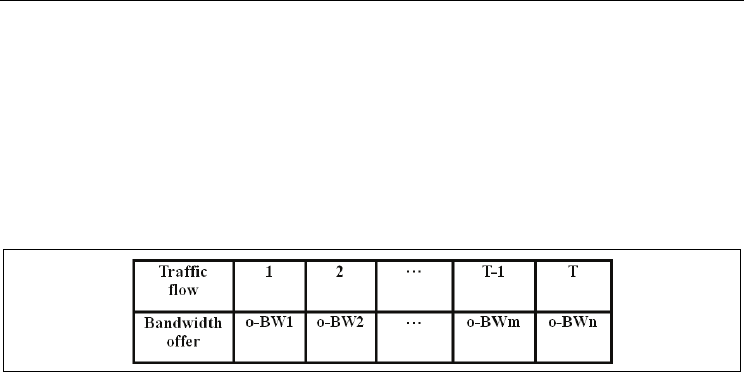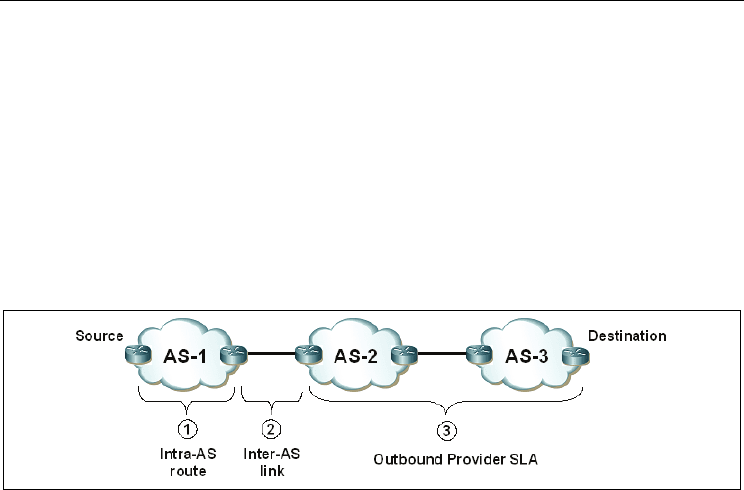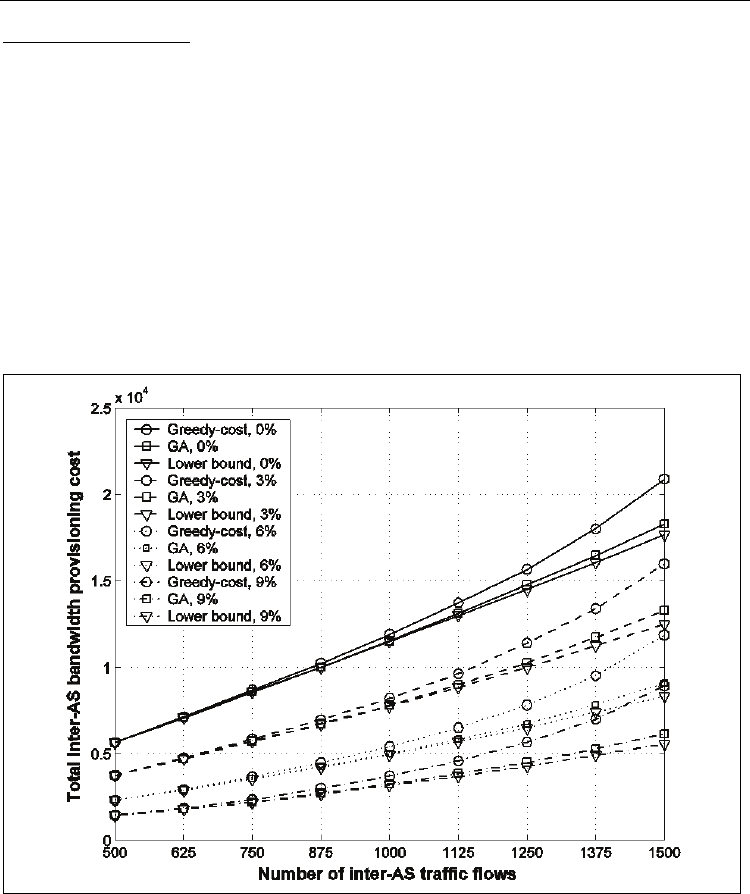Bednorz W. (ed.) Advances in Greedy Algorithms
Подождите немного. Документ загружается.


Solving Inter-AS Bandwidth Guaranteed Provisioning Problems with Greedy Heuristics
511
4.2 Modified inter-AS bandwidth provisioning problem
We assume that when multiple bandwidth offers towards the same remote destination
prefix k are present at a given border router j (i.e.
,
0
jn
k
nMaxBw
>
∃
), the AS has already
determined the best one as a candidate bandwidth offer. Thus, each border router will
consider at most one bandwidth offer towards each remote destination. The decision of
selecting the best bandwidth offer might be based on business factors such as the
relationships between ASes and the reputations of adjacent downstream ASes. As a result of
this assumption, the variable
,
j
n
k
y
of which bandwidth offer has been considered for each
remote destination prefix k at each border router j is pre-determined and this satisfies
constraint (7) since at most one bandwidth offer will be considered (i.e.
1
,
j
nNEXT
k
jn
y
∈
≤
∑
).
Therefore, constraint (7) is automatically enforced.
4.3 A Lower bound of the inter-AS bandwidth provisioning problem
We derive an approximated optimal solution of the IBP problem that can be obtained
efficiently by relaxing some constraints. This approximated optimal solution is thus a lower
bound of the IBP problem. A lower bound typically has better result than the optimal
solution because some problem constraints are relaxed. However, due to the relaxation, it is
not a valid solution to the problem. Nevertheless, the lower bound is a good approximation
of an optimal solution for heuristic algorithms to compare their performance. We show the
derivation of a lower bound for the IBP problem as follows.
We derive a lower bound by relaxing some IBP problem constraints. First of all, constraint
(7) is automatically enforced by our assumption that each border router has only considered
the best candidate bandwidth offer towards each remote destination prefix. Second, we
relax the non-bifurcation integer constraint (4). In many practical situations, integer
programming problems, which require all variables to be integers, are NP-hard. Instead, a
linear programming problem that has only non-integer variables can be generally solved
efficiently in the worst case. Therefore, we relax constraint (4) to
,
,
01
jn
ik
x
≤
≤ , non-integer (8)
Finally, we find that a lower bound can be readily calculated by the following method if
inter-AS link capacity constraint (2) is relaxed. Relaxation of a capacity constraint means that
the constraint is simply ignored based on the assumption that capacity is large enough to
accommodate the traffic.
Given
,,
,
kjn
jn
low
k
Chg
Min
Pr
∀
=
and
,,
,
kjn
j
n
high
k
Chg
Max
Pr
∀
=
, we can define
,
,
|
j
jn
jn
kk
k
jJnNext
Chg
b MaxBw
ψ
ψ
∈∈
==
∑∑
low high
and k K
Pr Pr
ψ
∀
≤≤ ∈
(9)
where
0
k
b
ψ
≥
is the sum of maximum capacity of all the bandwidth offers to remote
destination prefix k with a charge equal to
ψ
, and
'( , )
k
iI
tik
d
∈
=
∑
kK
∀
∈ (10)

Advances in Greedy Algorithms
512
where d
k
≥ 0 is the sum of bandwidth demands of all the traffic flows to destination prefix k.
For each traffic demand d
k
towards remote destination prefix k, we first attempt to assign it
to the lowest cost bandwidth offer. If the lowest cost bandwidth offer cannot entirely
accommodate the traffic demand due to capacity limitation, then the residual demand will
be assigned to the next lowest cost bandwidth offer. This traffic demand assignment iterates
until the bandwidth offer with a particular cost can entirely accommodate the traffic
demand. A lower bound is calculated based on the traffic assigned to each bandwidth offer
and its associated cost. A lower bound, using the abovementioned method, can be
calculated by
1
,0 ,
high
low low
Pr
Pr Pr
kkk
kK
Min Max
dbb
ψ
αψ
ψα
ψ
−
∈= =
−⋅
⎧
⎡⎛ ⎞⎤⎫
⎨
⎬
⎜⎟
⎢⎥
⎩⎣⎝ ⎠⎦⎭
∑∑ ∑
(11)
For a particular cost
ψ
, the max function determines the residual traffic demand that has not
been allocated to the bandwidth offers that have lower cost than the one being considered.
The min function attempts to assign this residual traffic demand to the bandwidth offer with
the cost currently being considered. The inner summation symbol considers all bandwidth
offers toward a remote destination prefix with different costs. The outer summation symbol
considers all the remote destination prefixes.
4.4 A genetic algorithm embedded with greedy heuristics
We propose an efficient Genetic Algorithm (GA) to obtain a near-optimal solution of the IBP
problem. Genetic Algorithm is an algorithm that operates by the natural selection of
‘survival of the fittest (Holland 1975). It has been successful in solving many large-scale
optimization problems. In order to making the proposed GA in solving the IBP problem
more efficiently, we propose two problem-specific greedy heurtsics embedded into the GA.
To solve the IBP problem, we modify and extend the GA (Chu & Beasley, 1997) proposed
for solving the Generalized Assignment Problem (Martello & Toth, 1990). The steps of our
GA are as follows:
Step 1. Create a feasibility mapping table which maps all the feasible bandwidth offers to
each inter-AS traffic flow. A bandwidth offer
,jn
k
oBw
is feasible for an inter-AS traffic flow
t’(i,k) if the following constraints are satisfied:
,
()
jn
k
Out k
oBw
∈
(12)
'( , )
j,n
inter
tik
c
≤
(13)
,
'( , )
jn
k
tik
M
axBw
≤
(14)
Constraint (12) ensures that the remote destination prefix in the bandwidth offer matches
the requested remote destination prefix of the traffic flow. Constraints (13) and (14) ensure
respectively that the bandwidth demand of the traffic flow does not exceed the capacity of
either the inter-AS link to which the bandwidth offer is associated or the maximum capacity
of the bandwidth offer. These constraints, however, do not guarantee that constraints (2) or
(3) are met for the entire chromosome.

Solving Inter-AS Bandwidth Guaranteed Provisioning Problems with Greedy Heuristics
513
Step 2. Generate an initial population of C randomly constructed chromosomes. Fig. 4
shows a representation of an individual chromosome which consists of T genes where T is
the number of inter-AS traffic flows and each gene represents an assignment between a
traffic flow and a bandwidth offer. The identifier given to each traffic flow represents each
inter-AS traffic flow ť(i,k). Let S
ť(i,k),c
= <k,j,n> represent the bandwidth offer
,
j
n
k
oBw
that has
been assigned to traffic flow ť(i,k) in chromosome c
∈
C. Each gene of the initial chromosomes
is generated by randomly assigning a feasible bandwidth offer to each traffic flow according
to the feasibility mapping table created in step 1. Note that an initial chromosome may not
be a feasible solution as capacity constraint (2) or (3) could be violated.
Fig. 4. Representation of an individual’s chromosome
Step 3. Decode each chromosome to obtain its fitness value. The fitness of chromosome c is
equal to the total inter-AS bandwidth provisioning cost, given by
'( , ),
()'(,)
tikc
iIkK
sChg t i k
∈∈
−⋅
∑
∑
(15)
The negative sign reflects the fact that a solution with lower cost has higher fitness. We
define
'( , ),
()'(,)
tikc
sChg t i k
⋅
to be the IBP cost for the traffic flow ť(i,k). If the chromosome
contains an infeasible solution, a common approach is to penalize its fitness for the
infeasibility. Instead of this, we adopt the approach in (Chu & Beasley, 1997) and associate
an unfitness value for each chromosome. The unfitness value of chromosome c is the degree
of infeasibility of the chromosome, which equals the amount of violated capacity summed
over all the inter-AS links and all the bandwidth offers,
'( , ),
,: ,,
0 , '( , )
jtikc
j,n
inter
jJnNext iIkKS kjn
Max t i k
c
∈∈ ∈∈ =< >
⎧
⎫
⎪
⎪
−
⎨
⎬
⎪
⎪
⎩⎭
∑∑ ∑
+
'( , ),
,
:,,
0 , '( , )
jtikc
j
n
k
kKjJnNext iIS kjn
Max t i k
MaxBw
∈∈∈ ∈ =< >
⎧
⎫
⎪
⎪
−
⎨
⎬
⎪
⎪
⎩⎭
∑∑ ∑ ∑
(16)
With the separation of fitness and unfitness values, chromosomes can be evaluated in a two-
dimensional plane, so the selection and replacement can direct the search towards feasible
solutions by replacing highly unfit chromosomes with lightly unfit or entirely fit ones.
Step 4. Select two parent chromosomes for reproduction. We use the pairwise tournament
selection method. In pairwise tournament selection, two individual chromosomes are
chosen randomly from the population and the one that is fitter (higher fitness value) is
selected for a reproductive trial. Two pairwise tournament selections are held, each of which
produces one parent chromosome, in order to produce a child chromosome.

Advances in Greedy Algorithms
514
Step 5. Generate two child chromosomes by applying a simple one-point crossover operator
on the two selected parents. The crossover point p
co
is randomly selected. The first child
chromosome consists of the first p
co
genes from the first parent and the remaining (n − p
co
)
genes from the second parent. The second child chromosome takes the parent genes that
have not been considered by the first child chromosome.
Step 6. Perform a probabilistic mutation on each child chromosome. The mutation simply
exchanges elements in two selected genes (i.e. exchange the assigned bandwidth offers
between two randomly selected traffic flows) without violating constraints (12) – (14).
Step 7. The fitness and unfitness values of child chromosomes can be improved by applying
the following two problem-specific heuristic operators:
• Heuristic-A
: For each inter-AS traffic flow that has been assigned to an infeasible
bandwidth offer such that either capacity constraint (2) or (3) is violated, find a feasible
bandwidth offer that incurs the lowest IBP cost for the traffic flow. Denote Δť(i,k) the
difference between the original IBP cost induced by the traffic flow and the new IBP
cost after the traffic flow has been reassigned to a feasible bandwidth offer. Among
those inter-AS traffic flows, select the one with the lowest Δť(i,k) and assign it to the
corresponding selected feasible bandwidth offer. This heuristic operator iterates at most
H times where H is a parameter that optimizes the algorithm’s performance or stops
when no inter-AS traffic flows have been assigned to infeasible bandwidth offers.
• Heuristic-B
: For each inter-AS traffic flow, find a feasible bandwidth offer that produces
the lowest IBP cost. If such a feasible bandwidth offer has been found, reassign the
traffic flow to it.
Heuristic-A aims to reduce the unfitness value of the child chromosome by reassigning
traffic flows from infeasible to feasible bandwidth offers while keeping the total IBP cost as
low as possible. Heuristic-B attempts to improve the fitness of the child chromosome by
reassigning traffic flows to feasible bandwidth offers with lower costs.
Step 8. Replace two chromosomes in the population by the improved child chromosomes. In
our replacement scheme, chromosomes with the highest unfitness are always replaced by
the fitter child chromosomes. If no unfit solution exists, the lowest fitness ones are replaced.
Step 9. Repeat step 4 - 8 until N
cd
child chromosomes have been produced and placed in the
population.
Step 10. Check if the GA termination criterion is met. The termination criterion is that either
both the average and the best fitness over all the chromosomes in the two consecutive
generations are identical or once the selected number of iterations, N
it
, has been reached in
order to avoid excess algorithm execution time. Steps 4 - 9 iterate until the termination
criterion is met.
5. Optimal traffic assignment
Let us assume that the bandwidth offers selected by the IBP (Section 4) have now been
accepted and configured as a set of outbound provider SLAs. Given this set and the
available bandwidth capacity within the AS, we now consider how to assign routes to the
traffic so as to meet the traffic’s bandwidth requirements. Fig. 5 shows that from the
viewpoint of AS-1, a route to the destination can be decomposed into three parts: (1) the
intra-AS route, (2) the inter-AS link and (3) the inter-AS route from the downstream AS (AS-
2) to the destination AS (AS-3). Sufficient bandwidth must be provisioned in all parts of this
route in order to satisfy the bandwidth demand. Once the outbound provider SLA is

Solving Inter-AS Bandwidth Guaranteed Provisioning Problems with Greedy Heuristics
515
known, the available bandwidth resource on any part of the route is known to the AS: the
intra- and inter-AS links are owned by the AS and the available bandwidth from the
downstream AS to the destination AS is guaranteed by the outbound provider SLA. As a
result, the TA problem can be defined as follows:
Given a set of outbound provider SLAs, an inter-AS TM and a physical network topology, assign
end-to-end routes to the supported traffic so that the bandwidth requirement is satisfied while
optimizing network resource utilization. A route assignment includes the selection of an outbound
provider SLA, an inter-AS link and an explicit intra-AS route from the ingress router to the egress
router where the selected outbound provider SLA is associated.
We assume that explicit intra-AS routes are implemented by MPLS. In addition, there are many
optimization criteria for network resource utilization, such as minimizing resource
consumption or load balancing. For simplicity, the network resource utilization used in this
chapter is a general metric, the total bandwidth consumed in carrying traffic across the network.
Fig. 5. Essential components for end-to-end bandwidth guarantee
5.1 Traffic assignment problem formulation
As with the IBP problem of Section 4, we formulate the TA problem as an integer-
programming problem. The fundamental objective is to provide bandwidth guarantees to
inter-AS traffic by satisfying their bandwidth demands. We define the bandwidth demand
of an inter-AS traffic flow t(i,k) to be met if the following three constraints are satisfied:
There exists at least one feasible path fpath∈Pi,
j
from in
g
ress router i to e
g
ress router
j
to
which the selected outbound provider SLA is associated , i.e.
intra
(, )
path
l
lf
tik
Min bw
∀∈
≥
(17)
,
(, )
jn
inter
tik
bw
≥
(18)
(,, ) (, )
p
SLABw k j n t i k≥
(19)
Constraint (17) ensures that there exists at least one feasible path between the ingress point
and the selected egress point, and the bottleneck bandwidth of the path is not less than the
bandwidth demand of the traffic flow. Constraints (18) and (19) ensure that the inter-AS link
and the outbound provider SLA respectively have sufficient bandwidth to accommodate the
traffic flow.
The objective of minimizing the total bandwidth consumption within the network can be
translated to the problem of minimizing the total number of hops that a traffic flow must
traverse in the network, i.e.

Advances in Greedy Algorithms
516
()
,
,
,
(,,) ()
,
jn
k
ij
ik
iIkKoBwkjn Outk
tik
dist
Minimize
z
∈∈ ∈
⋅⋅
∑∑ ∑
(20)
subject to:
,
,
,
(, )
j
n
jn
ik
inter
iIkK
tik
c
z
∈∈
⋅≤
∑∑
( , ) where ,
j
jn j Jn NEXT
∀
∈∈ (21)
,
(, )
l
l
ik
intra
iIkK
tik
c
∈∈
⋅≤
ϒ
∑∑
lE
∀
∈
(22)
,
,
,
(, )
jn
j
n
k
ik
iI
tik
pSLAC
z
∈
⋅ ≤
∑
(,,) where , ,
j
kjn k Kj Jn NEXT
∀
∈∈∈
(23)
{}
,
,
,
,
,, 0,1
p
jn
l
ik
ik
ik
w
z
∈
ϒ
(24)
()
,
,
(,,)
1
jn
ik
oBw k j n Out k
z
∈
=
∑
( , ) where ,ik i Ik K
∀
∈∈ (25)
,
,
1
ij
P
p
ik
p
w
∈
=
∑
( , ) where ,ik i Ik K
∀
∈∈ (26)
,
,
p
l
ik
ik
w
≤
ϒ
,
( , , , ) where , , ,
ij
lpik l pp P i Ik K
∀
∈∈ ∈∈ (27)
Constraints (21), (22) and (23) ensure that the total traffic assigned to the inter-AS link, the
intra-AS link and the outbound provider SLA do not exceed their respective capacities.
Constraint (24) ensures the discrete variables assume binary values. Constraint (25) ensures
that only one outbound provider SLA is selected for each traffic flow. Constraint (26)
ensures that each traffic flow t(i,k) is routed along a single intra-AS route in order to
preserve scalability and minimize network management complexity. Constraint (27) ensures
that, whenever traffic flow t(i,k) is assigned to intra-AS link l, then the path to which l is
associated must have been selected. Moreover, given the lossless property of the links, an
additional constraint that has not been presented is the flow conservation constraint which
ensures that the traffic flowing into a node must equal the traffic flowing out of the node for
any intermediate node.
5.2 A greedy heuristic algorithm for the traffic assignment problem
In comparing the two problems in the network dimensioning system, the complexity of the
TA Problem is higher than the IBP problem, in terms of number of decision variables and
constraints. In addition, the TA is performed more frequently than the IBP: network capacity
expansion is usually less frequent than traffic engineering. Based on these reasons, the
algorithm for solving the TA problem should be more efficient than the IBP algorithm. In
general, a GA can produce a better performance but with higher time complexity than
simple greedy-based heuristics. Due to the higher complexity of the TA problem, we do not
consider using GA to solve the TA problem as we did for the IBP problem. Instead, we
present a simple and efficient greedy heuristic algorithm to solve the TA problem, namely
greedy-penalty heuristic.

Solving Inter-AS Bandwidth Guaranteed Provisioning Problems with Greedy Heuristics
517
Greedy-penalty heuristic
: It is possible that the order in which traffic flows are assigned to
outbound provider SLAs may produce different selection results. For example, if we take a
traffic flow t(i,k) = 2, we might assign it greedily to some outbound provider SLA
,
j
n
k
pSLA
with intra-AS distance
,
k
ij
dist
= 3. In this case, the total bandwidth consumed equals 6. If on
the other hand we allocate it later in the process, the outbound provider SLA may not have
sufficient bandwidth because its bandwidth has been allocated to other traffic flows and the
considered traffic flow might have to be assigned to another outbound provider SLA
', '
j
n
k
pSLA
, for example, with
,'
k
ij
dist
= 6. As a result, the total bandwidth consumed equals
12. In this case, we have a penalty on the consumption of additional bandwidth (i.e. 12 − 6 =
6) and we use penalty to refer to this value. A penalty-based algorithm aims to minimize the
number of hops a flow must traverse by placing customer traffic flows in certain order
according to penalty. We propose a greedy-penalty heuristic algorithm that takes into
consideration the penalty value. Such an algorithm has also been used to solve the GAP
(Martello & Toth, 1990).
Step 1 For each unassigned traffic flow, we measure the desirability of assigning it to each
feasible outbound provider SLA that satisfies constraint (19). The desirability is the total
bandwidth consumed by the traffic flow along the intra-AS route between the ingress and
the egress router with which the outbound provider SLA is associated (i.e. the number of
intra-AS hops times the bandwidth demand). Intra-AS route computation is done by
Constrained Shortest Path First (CSPF) (Osborne & Simha, 2002), which finds a route that is
shortest in terms of hop while satisfying the bandwidth requirement. The smaller the
desirability, the smaller amount of bandwidth to be consumed, and thus the better the
selection.
Step 2 Compute penalty for each unassigned traffic flow, being the difference between the
desirability of the traffic flow’s best and second best selection (i.e. the two outbound
provider SLAs which yield the smallest desirability). If there is only one feasible outbound
provider SLA with sufficient spare capacity to accommodate the traffic flow, we need to set
penalty to infinity and immediately assign the traffic flow to it. Otherwise, this outbound
provider SLA may subsequently become unavailable, resulting in an invalid solution.
Step 3 Among all unassigned traffic flows, the one yielding the largest penalty is placed with
its best selection. In other words, this traffic flow is assigned to the feasible outbound
provider SLA that achieves the smallest desirability. If multiple traffic flows which have the
same largest penalty exist, the one with the largest bandwidth demand is placed. If there are
several such traffic flows, one is chosen randomly.
Step 4 Once the outbound provider SLA is selected, the requested bandwidth is allocated on
the corresponding selected intra-AS route and the outbound provider SLA to establish an
end-to-end bandwidth guaranteed route. We iterate step 1 to step 4 until all the traffic flows
have been considered.
6. Performance evaluation
We evaluate the proposed GA and the greedy-penalty heuristic algorithms by simulation.
The simulation software was written in Java. The computation was carried out on a laptop
with an Intel Pentium Centrino 1.5GHz Processor with 512MB RAM. All the results
presented in this chapter are an average of 50 different simulation trials.

Advances in Greedy Algorithms
518
6.1 Network model
We use a network topology generated by BRITE (Brite) with 100 nodes and average node
degree of 4. These numbers were chosen to represent a medium to large INP topology. All
intra-AS links are unidirectional and each has capacity of 500 units. Note that, since no
realistic data is publicly available, we assume that the values of link capacity, bandwidth
offers, and traffic demand are unitless. Therefore, these values that we use in this chapter
may represent any specific value depending on the definition of the corresponding unit.
Among the 100 nodes, 30 nodes are randomly selected as border routers and the remaining
nodes are core routers. In practice, each border router may connect with several inter-AS
links to adjacent ASes. However, for simplicity, and without loss of generality, we abstract
these inter-AS links into one. Thus, each border router is associated with one virtual inter-
AS link which can logically represent one or multiple physical inter-AS links. Therefore, 30
virtual inter-AS links are considered and each has capacity of 500 units.
6.2 Bandwidth offer model
It is well known that whilst a typical default-free routing table may contain routes for more
than 100,000 prefixes, only a small fraction of prefixes are responsible for a large fraction of
the traffic (Feamster et al., 2003). Based on this finding, we consider 100 remote destination
prefixes to be included in the bandwidth offers. In fact, each of them may not merely
represent an individual prefix but also a group of distinct address prefixes that have the
same end-to-end path properties, e.g. geographical location, offering AS and maximum
available bandwidth. Hence, the hundred prefixes we considered could reflect an even
larger number of prefixes.
In a network, each border router can be an ingress or egress point. Without loss of
generality, we consider the network scenario where if a border router receives a bandwidth
offer towards destination prefix k from adjacent AS Y, then AS Y cannot inject traffic for k
into it. This corresponds to multi-hop traffic (Feldmann et al., 2001) in which the traffic
traverses the network instead of being directed to another egress link of the same border
router. We adopt this model in order to evaluate the TA objective of total bandwidth
consumption in the network. As a result, we cannot assign all the destination prefixes on
each border router as bandwidth offers. Instead, at each border router we randomly select
half of these hundred destination prefixes as bandwidth offers and the other half as inter-AS
traffic. In other words, we set the average number of distinct bandwidth offers advertised at
each border router to be half of the number of prefixes. Furthermore, each border router can
generate the number of traffic flows towards half of these prefixes that have not been
selected for bandwidth offers. We note that this destination prefix generation process is just
a best effort attempt to model prefix distribution, as no synthetic model for the actual
behavior of prefix distribution in real networks was found in the literature. The remote
destination prefixes associated with the bandwidth offers are randomly selected. The
maximum capacity of each bandwidth offer is uniformly generated between 100 and 200
units. The charge associated with each bandwidth offer varies according to the simulation
scenarios.
6.3 Traffic model
Ingress points and remote destination prefixes of the inter-AS traffic matrix are randomly
generated. Previous work has shown that inter-AS traffic is not uniformly distributed (Fang

Solving Inter-AS Bandwidth Guaranteed Provisioning Problems with Greedy Heuristics
519
& Peterson, 1999). According to (Broido et al., 2004)), the AS traffic volumes are top-heavy
and can be approximated by a Weibull distribution with shape parameter 0.2-0.3. We
therefore generate the inter-AS TM with traffic demand following this distribution with the
shape parameter 0.3. As previously mentioned, we do not allow traffic-prefix looping, so
that if the AS receives a bandwidth offer towards remote destination prefix k from an
adjacent AS, then this adjacent AS cannot inject traffic into the AS for k. The number of inter-
AS traffic flows to be considered ranges from 500 to a maximum 1500.
As mentioned in Section 3.1, each inter-AS traffic flow is an aggregate of individual traffic
flows that have identical ingress points and remote destination prefixes. Hence, the number
of inter-AS traffic flows we considered does not reflect the exact total number of individual
traffic flows. Instead, the number could represent more individual traffic flows. We assume
that moderate overprovisioning is considered by the IBP and unless specified, f
over
= 1.25 (i.e.
25% inter-AS bandwidth overprovisioning). Table 2 shows the number of traffic flows, their
corresponding traffic volume and overall inter-AS link utilization. Note that the total traffic
volume presented in the table has already taken into account the overprovisioning factor.
Number of traffic
flows
Total Traffic volume
Overall inter-as egress link
utilization (%)
500 4465 30%
625 5578 37%
750
6719 45%
875 7813 52%
1000 8915 60%
1125 10046 67%
1250 11142 74%
1375 12259 82%
1500 13402 90%
Table 2. Inter-AS traffic
6.4 Algorithm parameters
For the IBP’s GA parameters, we adopt the suggested values from previous GA research to
achieve satisfactory effectiveness and convergence rate of the algorithm (Lin et al., 2003).
The population size is 200, the value of H of the heuristic operator (a) is 200 since the IBP
problem is highly constrained by two capacity constraints, N
cd
is set to 50, the probability of
mutation is 0.01 and N
it
is set to 100.
6.5 Evaluation of the IBP algorithms
We compare the performance of our proposed GA described in Section 4.4 with the
following alternatives:
Greedy-cost heuristic
: The Greedy-cost heuristic sorts all the inter-AS traffic flows in
descending order of bandwidth demand and selects one at a time in that order. From the
bandwidth offers that have sufficient bandwidth to accommodate the given traffic flow, we
select the one which incurs the least IBP cost. The flow is then allocated to this bandwidth
offer and its corresponding inter-AS route. This step is repeated for the next traffic flow until
all flows have been considered. One can imagine this heuristic might be a conventional
algorithm used by INPs to solve the IBP problem.

Advances in Greedy Algorithms
520
Greedy-random heuristic
: A greedy-random heuristic algorithm is included as a baseline
comparison. The random heuristic algorithm is similar to the Greedy-cost heuristic except
that the bandwidth offer selection of traffic flows is done at random. It may be viewed as the
solution obtained by a trial-and-error or an ad hoc IBP approach.
6.5.1 Evaluation of the Total IBP Cost
The aim of the proposed GA is to achieve better and near-optimal IBP cost in comparison
with the alternative algorithms. Hence, the main objective of the evaluation in this section is
to quantify the effectiveness of the proposed GA over the alternative algorithms.
Fig. 6 shows the total IBP cost achieved by the Greedy-cost and the GA as a function of
inter-AS traffic flows. The performance of the Greedy-random heuristic is not presented in
this figure since it has a significant performance gap from the other heuristics. Nevertheless,
it is compared to the alternative algorithms in Table 3. The legend in the figure shows the
names of the algorithms followed by the percentage of established peering connections as
mentioned at the beginning of Section 4.
Fig. 6. Evaluation of the total inter-AS bandwidth provisioning cost
The figure presents the results of two practical scenarios, and we evaluate whether the
proposed GA performs consistently well under these scenarios. The first scenario consists of
all customer-provider connections. In other words, no peering connection (i.e. 0%) is
established and the charge of each bandwidth offer is non-zero. We generate an integer
uniformly between 1 and 10 to represent each cost. The figure shows that the GA has a
lower total IBP cost at all numbers of inter-AS traffic flows. We conjecture that when the
